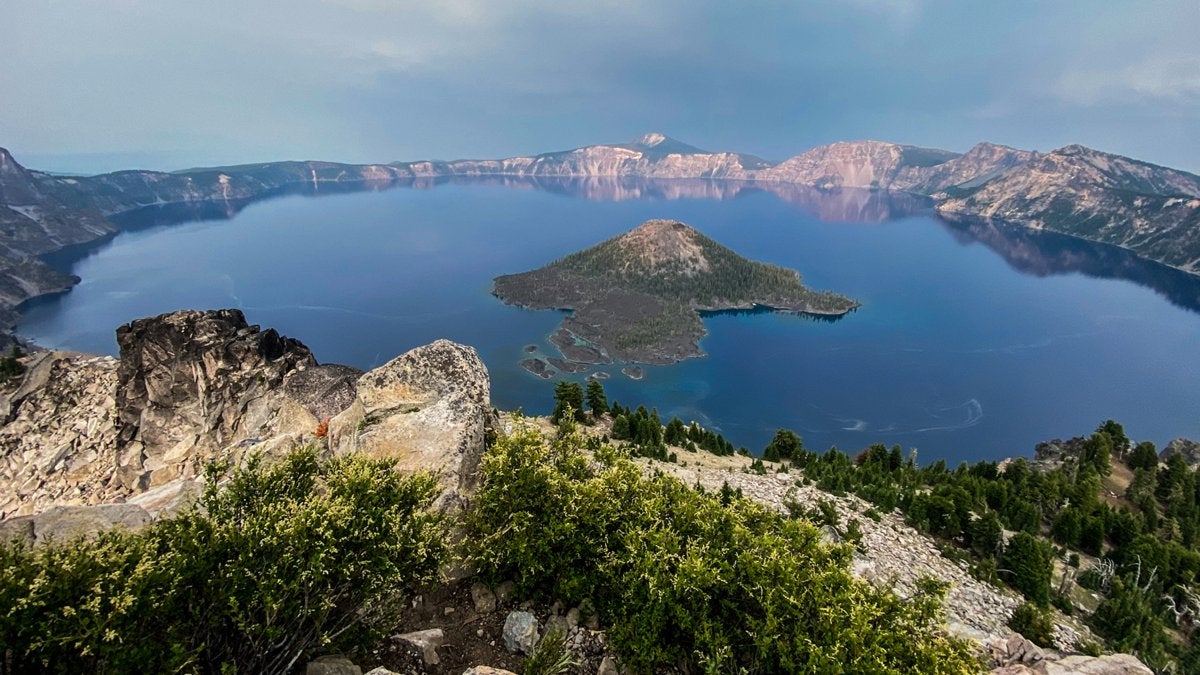No products in the cart.
Outdoor Adventure
Otherworldly Adventure at Crater Lake National Park
62 Parks Traveler started with a simple goal: to visit every U.S. national park. Avid backpacker and public-lands nerd Emily Pennington saved up, built out a tiny van to travel and live in, and hit the road. The parks as we know them are rapidly changing, and she wanted to see them before it’s too late.
Pennington is committed to following CDC guidelines during the COVID-19 pandemic to ensure the safety of herself and others. She’s visiting new parks while closely adhering to best safety practices.
Laying eyes on Crater Lake is like being sucked through an interdimensional portal. Something about the impossibly deep sapphire water carries an almost mystical quality that grabs you by the retinas and doesn’t let go. Friends warned me about a kind of otherworldly wallop upon arrival, but nothing could prepare me for the feeling I had seeing it for the very first time.
After a long, mid-July drive caravaning through southern Oregon’s pine forests, my friend Ave and I white-knuckled our way around a series of increasingly steep switchbacks on the park’s main highway. We took a sharp left onto Rim Drive, a high-altitude road (at 7,100 feet) that circumnavigates the five-mile-wide lake, and were soon met with the immense, blue shock of water at Discovery Point. Though several cars had pulled over into the lakeside parking lot, I wanted to face this natural wonder head-on, in the flesh, feet on the trail, so we drove onward and decided upon a 1.8-mile trek up to the Watchman Observation Station.
Lilac phlox, sulfur buckwheat, and tiny white lupines dotted the trail as we ascended to a fire tower nearly 2,000 feet above the lake’s surface. After rounding a bend and taking our final steps toward the overlook, we both froze. Most popular park lookouts can turn into a rowdy mess of selfie sticks and toddler wrangling, but this one felt different. There were several other tourists walking around snapping photographs and admiring the view, but they were all eerily silent. It was as though we all knew we were in the presence of something special.
Ave and I stayed here for over an hour, just sitting and staring as the sun sank and the light shifted. Haze from nearby forest fires made the scene feel more like an Impressionist painting than real life, blurring the edges of this ancient volcano into delicate shades of coral and fuzzy marigold.
On our second day, the smoke scattered in the midsummer breeze and high cumulus clouds, and the air was clearer. Starting at Discovery Point, we hiked north on the Pacific Crest Trail—33 miles of it bisect the park—in uncharacteristic 80-degree heat. Although boat tours had been suspended for the season due to COVID-19, the views of Wizard Island, which sits in the middle of the lake, along this less traveled path were no less stunning, and with a little luck, you might have the trail all to yourself. We stopped near 8,156-foot Hillman Peak and had lunch perched atop our very own tree root, with a million-dollar view.
Sticky from a week spent hiking and driving, I was eager to cap off the trip with a cooldown swim into the lake, so we sped off toward the park’s Cleetwood Cove Trail, the only legal access to its shore. A mile and 700 vertical feet later, we were at the water’s edge.

Small crayfish occasionally crept up from the darkness between the rocks surrounding our feet as we gleefully stripped down and plunged in. As the deepest lake in America, at 1,943 feet, swimming into the crater’s immense, blue void can feel overwhelming. You’re suddenly faced with a visceral depiction of just how small you are in the face of the natural world.
Yet somehow, after a chilly 55-degree swim amid its unfathomable depths, I emerged feeling stronger and more lit up than ever. It was the perfect bookend to a weeklong girls’ road trip. I knew I was ready to tackle whatever life hurled at me next, baptized in sunshine and smiles.
62 Parks Traveler Crater Lake Info
Size: 183,224 acres
Location: Southern Oregon
Created In: 1902 (national park)
Best For: Scenic drives, hiking, swimming, stargazing, geology
When to Go: Summer (33 to 70 degrees) and fall (22 to 63 degrees) are the seasons when the park is snow-free and most accessible by car. Expect road closures in spring (19 to 50 degrees) and winter (18 to 35 degrees).
Where to Stay: I skipped the crowds and found a site 30 minutes outside the park at Union Creek Campground—Rogue River, nestled in a grove of towering pines. It’s secluded enough to truly relax and soak up the forest energy.
Where to Eat: Adjacent to the campground and the Union Creek Lodge is Beckie’s Café, where hungry hikers can grab a seriously awesome burger and a slice of pie.
Mini Adventure: Go for a cruise along Rim Drive. This 50-mile scenic byway offers access to 30 overlooks and 33 miles of incredible Crater Lake views. Allow at least three hours to stop, walk around, and take pictures.
Mega Adventure: Summit Mount Scott. At 8,929 feet, this small stratovolcano is the highest point in Crater Lake National Park, and the views from the top are outstanding. Get ready for a heart-pumping climb on the 4.5-mile trail, then gaze down at the blue water and the Klamath Basin, beautiful rewards that testify how far you’ve come.
Lead Photo: Emily Pennington

